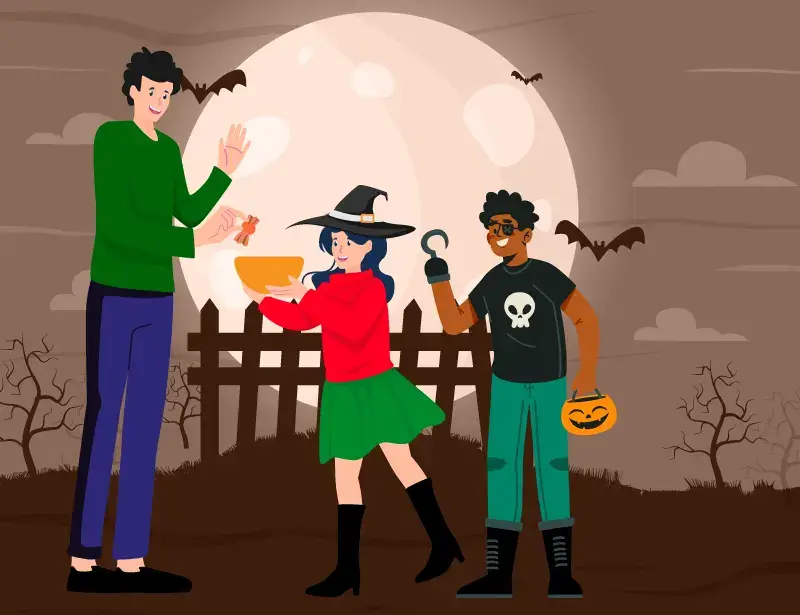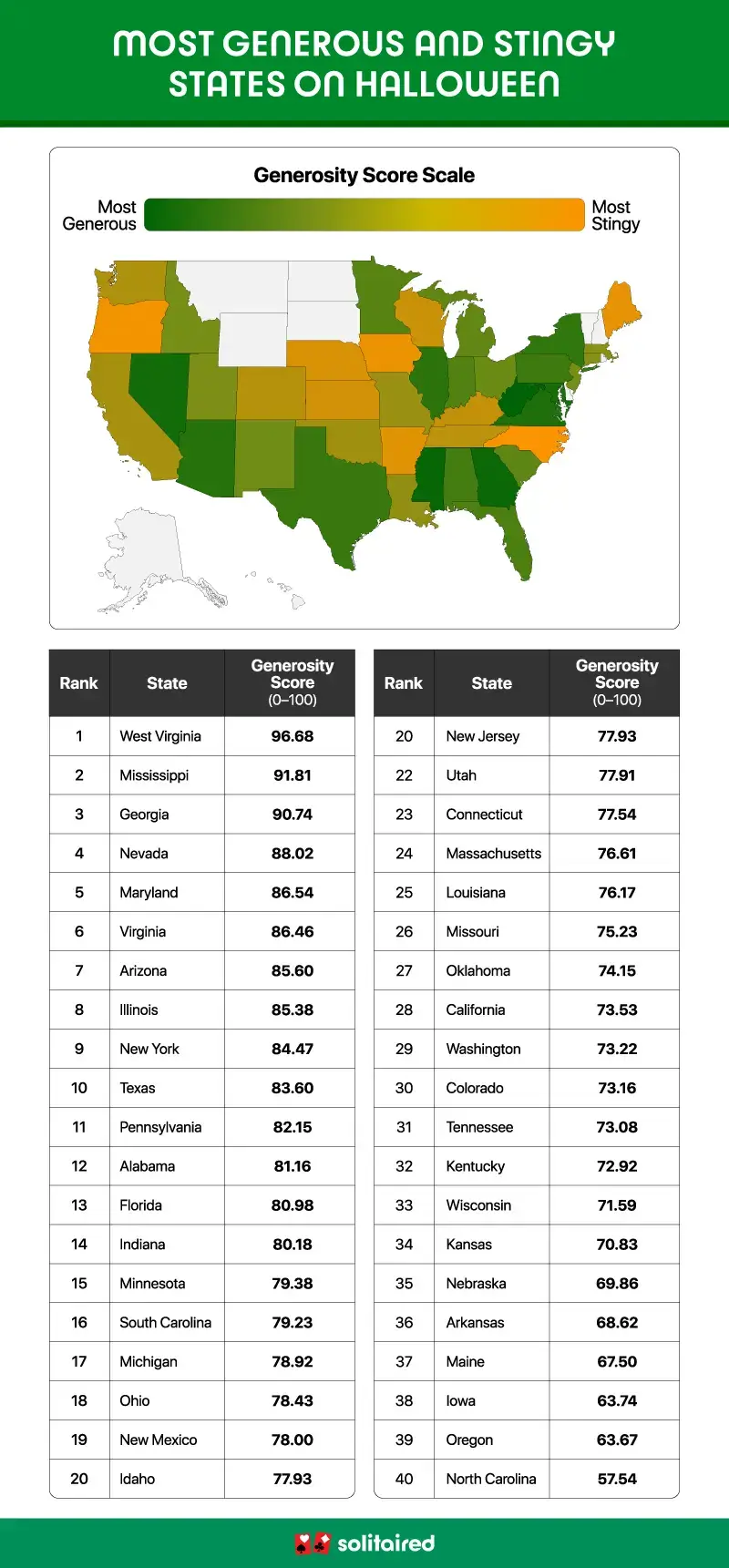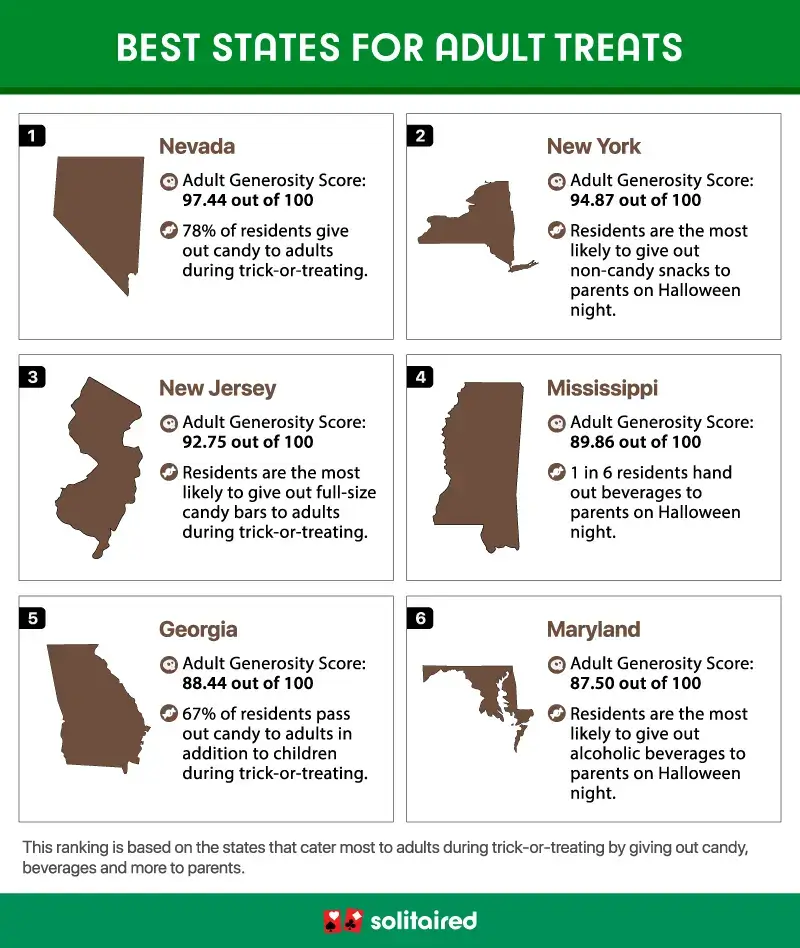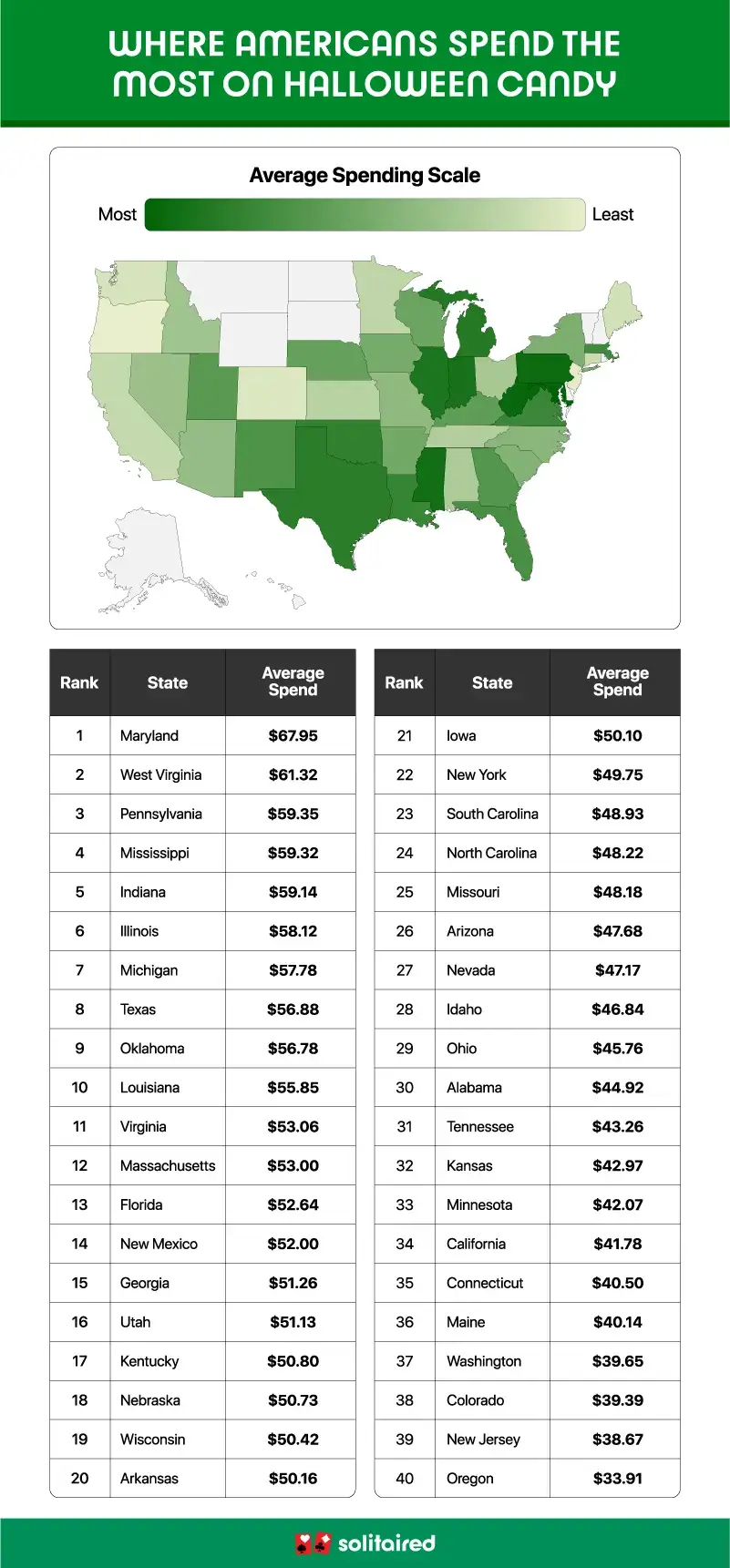The Most Generous and Stingy States on Halloween
By Neal Taparia - 10/09/2025

For decades, children have dressed up in all kinds of costumes on Halloween from scary monsters to cute princesses. And while costume trends have come and gone, one fact remains the same—everyone loves candy.
Regardless of age, it seems children (and their parents!) are always on the hunt to bring home the best candy haul during trick-or-treating. While some neighborhoods provide better results than others, kids quickly find out that some houses are downright generous and others can be a bit stingy.
At Solitaired, we know how scoring big can feel like a real win. We also know that on Halloween, many of you skip your daily game of solitaire to attend to trick or treaters. So we decided to survey Americans to learn which houses are dealing out the best hand on Halloween night. We asked a variety of questions about how much people spend on candy, how much they give out to each trick-or-treater, if they give goodies to parents, and more.
We then awarded points to responses that represented generosity on Halloween and calculated the average score by state. Finally, we adjusted those scores on a scale of 0 to 100, with 100 representing the most generous states. Read on to learn the best places to achieve a sugar rush this Halloween.
Key Takeaways
- West Virginia, Mississippi, and Georgia residents are the most generous on Halloween.
- North Carolina, Oregon, and Iowa residents are the most stingy on Halloween.
- The average American plans to spend about $49.19 on candy for trick-or-treaters this Halloween.
- Homes in Nevada, New York, and New Jersey are the most likely to give out goodies to parents during trick-or-treating.
- 55% of Americans say it's important to them to be known as the "good candy house" on Halloween.
- 1 in 5 Americans who don't give out candy on Halloween say it's because it's too expensive.
- 2 in 5 Americans admit they have pretended not to be home on Halloween to avoid giving out candy.
The Best Places for Trick-or-Treating

From full-size candy bars to allowing kids to pick out a handful of candy, many factors can make a house stand out on Halloween. By analyzing how much candy is passed out to each trick-or-treater, how much money is spent on candy, and more, we created a generosity score for each state to learn which have the best houses to visit on Halloween night.
Leading the way with a score of 96.68 out of 100 is West Virginia. In addition to being the most generous, West Virginia residents are second most likely to take part in trick-or-treating with 88% of people saying they typically give out candy.
Coming in second place is Mississippi with a generosity score of 91.81 out of 100. In this southern state, trick-or-treating is full of more than just candy as nearly 1 in 4 residents say they give out a mix of candy and non-candy items like glow sticks and toys.
Georgia rounds out our top three for generous states on Halloween with a score of 90.74 out of 100. While more than two-fifths of Americans give candy to children at random, 60% of Georgia residents leave the selection to the kids, ensuring they get what they want.
On the other end of the generosity scale are those who tend to be a bit stingy on Halloween. Beware, North Carolina trick-or-treaters: Your state received the lowest generosity score (57.54), meaning your candy buckets may be a bit lighter than those across the country. Overall, North Carolina residents are the least likely to say they typically give out candy on Halloween, and 41% don’t care about being viewed as a good candy house.
Oregon follows closely behind with a score of 63.67 out of 100, as 1 in 2 residents of the state admit they have pretended to not be home to avoid giving out candy to trick-or-treaters in the past. In third place for the most stingy is Iowa, where 53% of residents say they ration candy to make sure it lasts all night. Additionally, 1 in 6 Iowa residents admit they always keep the good candy for themselves and give kids cheaper candy instead.
Not everyone takes part in trick-or-treating, so in addition to learning which states are most generous and stingy, we also wanted to uncover the reasons Americans are skipping out on the festivities. The most common reason, with 63% of people noting it, is the lack of people trick-or-treating in their neighborhood.
The second most common reason is the cost, as 1 in 5 Americans say it’s too expensive. For another 18%, it’s simply that they don’t celebrate Halloween, and another 18% just don’t feel like taking part. For 17% of people, other plans like a party keep them from handing out candy. Finally, nearly 1 in 6 Americans spend the evening taking their own kids out trick-or-treating.
States That Cater Most to Parents During Trick-or-Treating

Halloween may be viewed as a holiday mostly for kids, but many parents get to take part as well. Sure there are parties and other adult activities on Halloween night, but for the parents who spend their evening taking their kids from house to house, several houses prepare goodies just for you.
As part of our study, we asked respondents if they give out items like candy, drinks, and other snacks to parents. Using these responses, we awarded points and calculated an average adult generosity score on a scale of 0 to 100. Leading the way with a score of 97.44 is Nevada where 78% of residents include adults by giving parents candy during trick-or-treating.
New York is up next with a score of 94.87 out of 100. On Halloween, residents of the Empire State are the most likely to give out non-candy snacks to parents. This is followed by New Jersey, where the residents are most likely in the country to give full-size candy bars to parents during trick-or-treating.
In some parts of the country, parents are even being gifted alcoholic beverages while making their laps around neighborhoods. Americans in Maryland, Texas, and Utah are the most likely to find not-so-ghostly spirits on their trick-or-treating route this Halloween.
States That Spend the Most on Candy for Trick-or-Treating

Overall, 79% of Americans typically pass out candy to trick-or-treaters on Halloween. So just how much are people spending each year? Well this year, the average person plans to spend $49.19 on candy. That comes as no surprise, however, as 78% of people say they typically keep their spending on candy at $50 or less each Halloween.
Zooming in by state, the real sugar rush happens in Maryland as the average resident typically spends about $68 on candy. This is followed by West Virginia ($61.32) in second place and Pennsylvania ($59.35) in third place. Overall, 1 in 9 Americans say they plan to spend more than $100 on candy for trick-or-treaters this year.
On the other side of the spectrum, we find Oregon at the bottom of our spending ranking with residents only budgeting about $34 for Halloween candy. New Jersey ($38.67) and Colorado ($39.39) follow closely behind claiming second and third place for the least money spent on candy each year.
With the average house expecting about 42 trick-or-treaters each year, it can get expensive offering a variety of high quality candies. Even still, 55% of Americans say it’s important to them to be known as a “good candy house” on Halloween.
No Tricks, Only Treats with Solitaired This Halloween
Halloween may be all about candy and costumes, but adults can have some fun, too. While the little ones race door to door, keep yourself entertained with Solitaired and try your hand at a free game of Klondike, FreeCell, Spider, Canfield, or Yukon. Even if no house on your route is passing out cocktails and candy to parents, these games can turn your night into a treat for you, too.
Methodology
In this study, we set out to learn which states are most generous and most stingy on Halloween night. To do this, we surveyed residents in every state and asked about their habits in relation to trick-or-treating. We asked a variety of questions from how much they spend on candy to their opinions on being known as a "good candy house."
We then awarded points to answers that represented generous behavior on Halloween, like giving out full-size candy bars and including parents in the festivities. Next, we calculated the average score by state, and then we adjusted those scores on a scale of 0 to 100, with 100 representing the most generous.
In addition to habits among candy-giving houses, we also asked those who do not give out candy about their reasons for not participating.
About the author

